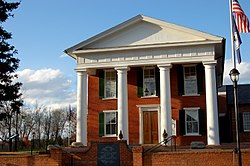Buckingham County, Virginia | |
|---|---|
 Buckingham County Courthouse | |
 Location within the U.S. state of Virginia | |
| Coordinates: 37°34′N78°32′W / 37.57°N 78.53°W | |
| Country | |
| State | |
| Founded | 1761 |
| Named after | Duke of Buckingham |
| Seat | Buckingham |
| Largest town | Dillwyn |
| Area | |
• Total | 584 sq mi (1,510 km2) |
| • Land | 580 sq mi (1,500 km2) |
| • Water | 3.9 sq mi (10 km2) 0.7% |
| Population (2020) | |
• Total | 16,824 |
| • Density | 29/sq mi (11/km2) |
| Time zone | UTC−5 (Eastern) |
| • Summer (DST) | UTC−4 (EDT) |
| Congressional district | 5th |
| Website | www |
Buckingham County is a rural United States county located in the Commonwealth of Virginia, and containing the geographic center of the state. [1] Buckingham County is part of the Piedmont region of Virginia, and the county seat is Buckingham. [2]
Contents
- History
- Geography
- Adjacent counties
- Major highways
- Demographics
- Racial and ethnic composition
- 2020 census
- 2010 Census
- Industry
- Traditional sectors
- Emerging: solar industry
- Controversies and regulatory issues
- Economic and social impacts
- Government
- County Administration
- Board of Supervisors
- Planning Commission
- School Board
- Constitutional officers
- State officials
- Federal officials
- Education
- Communities
- Town
- Census-designated places
- Unincorporated communities
- Notable people
- See also
- References
- External links
Buckingham County was created in 1761 from the southeastern portion of Albemarle County and was predominantly farmland. The county was probably named in honor of the Duke of Buckingham, though the precise origin is uncertain. Several changes were made to the borders, until the existing boundaries were established in 1860.
As of the 2020 census, the county population was 16,824. [3]



